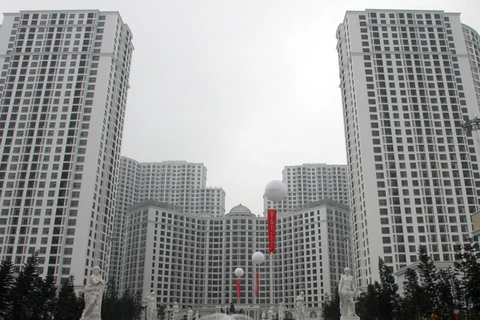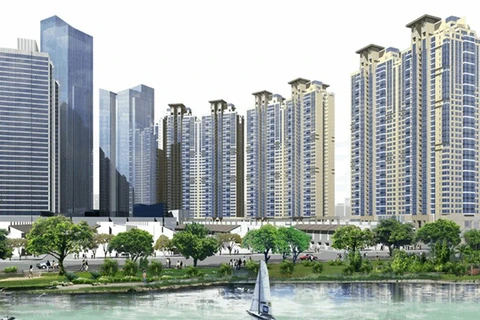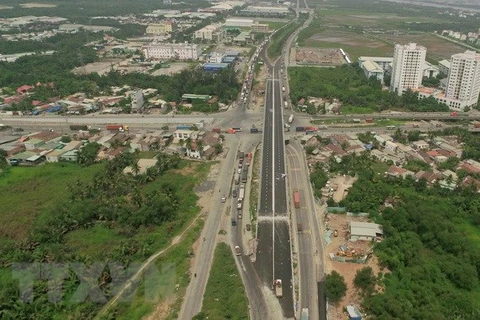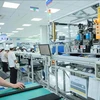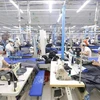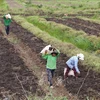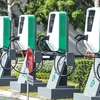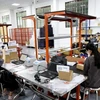 The HCM City Real Estate Association (HoRea) has recommended that the People’s Committee be more selective about giving licences to high-rise buildings.(Photo: VNA)
The HCM City Real Estate Association (HoRea) has recommended that the People’s Committee be more selective about giving licences to high-rise buildings.(Photo: VNA) HCM City (VNS/VNA) - The Ho Chi Minh City Real Estate Association (HoRea) has recommended that the municipal People’s Committee should be more selective about giving licences to high-rise buildings.
The high-end housing segment accounts for a high proportion of 8,502 units (30 percent), while the affordable housing segment has only 6,981 units (25.7 percent).
The property market needs more affordable housing for residents who comprise the majority of the population. Based on the current situation, the high-end housing segment is expected to face many challenges in 2019. High-end apartment projects will have to compete fiercely with each other to survive.
Meanwhile, some high-end apartment projects in the city centre have enjoyed many exclusive advantages as the city had previously decided to stop licensing other high-rise apartment projects from now to 2020.
HoRea has suggested that city authorities not prohibit licensing for high-rise apartment projects but carefully select quality investors.
Earlier, at a meeting with authorities, deputy director of the Housing Management and Real Estate Market Vu Van Phan said he was concerned about prices of existing apartments and that they could significantly increase due to the suspension of licences of new apartment projects.
According to the HCM City’s housing development plan between 2016 and 2020, new housing projects cannot be developed in the centre area including District 1 and 3.
Incomplete housing projects in districts 4, 5, 6, 8, 10, 11, Binh Thanh, Go Vap, Phu Nhuan, Tan Binh, and Tan Phu should be completed and that new projects should not be carried out unless there are plans for construction of quality infrastructure. Social housing projects are given priority in these districts.
Authorities in districts 2, 7, 9, 12, Binh Tan and Thu Duc should focus on completing unfinished housing projects while prioritising construction of new housing projects and condominiums along major public transport axes such as the Metro Line No.1 in districts 2, 9 and Thu Duc and areas with quality infrastructure.
Recently, the HCM City People’s Committee said the city would still offer licences for new housing projects in the central districts 1 and 3 in a selective manner.
In other districts with densely populated densities such as districts 4, 5, 6, 8, 10, 11, Binh Thanh, Go Vap, Phu Nhuan, Tan Binh and Tan Phu, HCM City will limit the number of new housing projects.
According to the HCM City Real Estate Association, the city now has over 400 of these projects, most of them in good locations and with large land parcels, and thus with the potential for big profits.
These projects could not go ahead because their developers did not have enough funds, said Nguyen Nam Hien, deputy general director of Hung Thinh Corporation.
There are many investors who would like to buy such prime lands for property projects but are faced with some legal challenges, he said, suggesting that banks should act as intermediaries and link up developers of stalled projects with potential investors.
“If the 400 projects resume, it will have a good effect on the market and banking sector,” he said.
Tran Duc Phuong of the HCM City Lawyers Association said: “The legal provisions for selling real estate projects should be relaxed.” Circular 194 related to the Land Law allows a development to be sold after the certificate of land use is obtained, he said.
But the certificate can only be obtained after construction. “This is the point that hinders mergers and acquisations in the property sector.”
The first project expected to get a new lease of life is the North West Urban Area straddling districts 12, Cu Chi and Hoc Mon.
It was approved in 2000 with several components, including the 650 ha An Phu Hung project in Tan Hiep and Tan Thoi Nhi communes of Hoc Mon district and dozens of housing, villa and apartment projects.
“In 2017 - 2018, the HCM City People’s Committee implemented a series of measures to promote construction in the project such as readjusting the master plan and completing the 1/5,000-scale map, and it is hoped that early this year construction will begin,” Vo Van Hoan, head of the People’s Committee Office, said.
The Thu Thiem New Urban Area in district 2 is the second one,with the city setting a target to develop it this year.
Nguyen Thanh Phong, Chairman of the city People’s Committee, said: “The Thu Thiem New Urban Area will seek to attract FDI.”
The Thanh My Loi A Urban Area in district 2 seems to have been reborn, with many prestigious developers like Novaland and Thu Thiem Real Estate company starting new projects here since last year.-VNS/VNA
But the certificate can only be obtained after construction. “This is the point that hinders mergers and acquisations in the property sector.”
The first project expected to get a new lease of life is the North West Urban Area straddling districts 12, Cu Chi and Hoc Mon.
It was approved in 2000 with several components, including the 650 ha An Phu Hung project in Tan Hiep and Tan Thoi Nhi communes of Hoc Mon district and dozens of housing, villa and apartment projects.
“In 2017 - 2018, the HCM City People’s Committee implemented a series of measures to promote construction in the project such as readjusting the master plan and completing the 1/5,000-scale map, and it is hoped that early this year construction will begin,” Vo Van Hoan, head of the People’s Committee Office, said.
The Thu Thiem New Urban Area in district 2 is the second one,with the city setting a target to develop it this year.
Nguyen Thanh Phong, Chairman of the city People’s Committee, said: “The Thu Thiem New Urban Area will seek to attract FDI.”
The Thanh My Loi A Urban Area in district 2 seems to have been reborn, with many prestigious developers like Novaland and Thu Thiem Real Estate company starting new projects here since last year.-VNS/VNA
VNA
